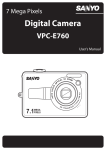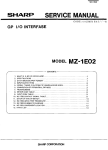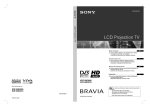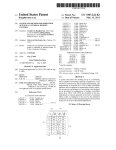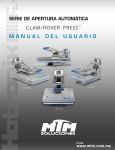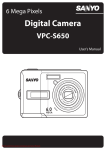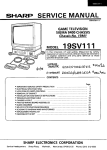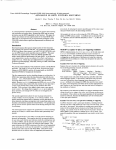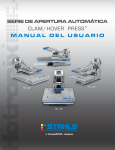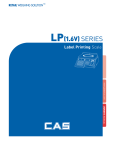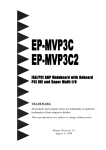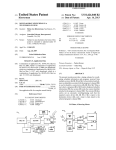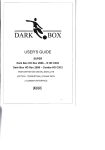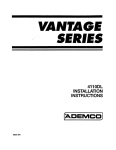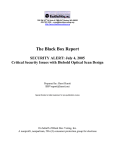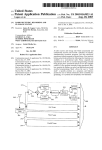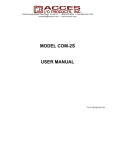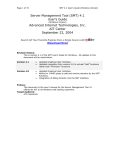Download Interactive remote control programming method
Transcript
US008754992B1
(12) United States Patent
Schulze et a].
(54)
US 8,754,992 B1
(10) Patent N0.:
(45) Date of Patent:
(56)
INTERACTIVE REMOTE CONTROL
PROGRAMMING METHOD
Jun. 17, 2014
References Cited
U.S. PATENT DOCUMENTS
(75) Inventors: Kim W. Schulze, Seattle, WA (US);
7,111,320 B1*
9/2006
Roshan Menon, Hermosa Beach, CA
7,378,984 B2 *
5/2008
Suzuki et a1. ..
(Us)
7,889,112
B1*
2/2011
Vergis et a1
2004/0143847 A1*
7/2004
Suzuki et a1. ..
(73) Assignee: The DIRECTV Group, Inc., El
Segundo, CA (U S)
Notice:
Subject to any disclaimer, the term of this
patent is extended or adjusted under 35
Novak ........................ .. 725/139
340/12.51
.......
. . . . . ..
341/176
. 725/61
2005/0110909 A1*
5/2005 Staunton et a1.
2007/0069918 A1*
3/2007
348/734
2007/0094703 A1*
4/2007 Nygaard et a1.
..... .. 725/135
2007/0225828
A1*
9/2007
Huang et a1.
. . . . . . . ..
2008/0191899 A1*
8/2008
Lee .............. ..
2009/0070696 A1*
3/2009
BelZ et al. ................... .. 715/771
You ........................ .. 340/825.69
... ....
700/11
340/825.22
* cited by examiner
U.S.C. 154(b) by 976 days.
Primary Examiner * J efferey Harold
(21) Appl. N0.: 12/341,976
Assistant Examiner * Musta?zur Rahman
_
(57)
(22)
Flled'
(51)
IIlt- ClH04N 5/44
(2011-01)
US, Cl,
USPC _________ __ 348/734; 348/725; 348/723; 348/585;
(52)
Dec' 22’ 2008
ABSTRACT
A system and method for programming a remote control
includes pressing keys to enter a programming mode. State
changes are communicated from the remote to a set top box.
A user selects a device to be controlled and instructions are
communicated to a user. The set top box tracks signals
received from the remote corresponding to a device code
348/569; 348/563; 348/114; 348/2114; 340/426_13; entered by the user into the remote. A program guides and
(58)
340/4.11; 340/12.22; 340/815.6; 725/61;
725/67; 725/81; 725/100; 725/132; 725/135;
informs the user of programming success or failure based on
725/140; 725/151
transmitter and runs a program associating a particular device
Field of Classi?cation Search
USPC ............... .. 348/734, 114, 569, 563, 723, 725;
code With a particular electronic device. The set top box
includes a receiver for receiving signals from the transmitter
340/426.13,4.11, 12.22, 815.6;
725/140, 81, 61, 135, 67, 100, 132,
725/151
signals received by the set top box. The remote includes a
and runs a program providing an interface on a display. The
interface guides the user through programming in response to
signals received by the set top box from the remote.
See application ?le for complete search history.
50
31 Claims, 12 Drawing Sheets
r52
54
r56
Elh
sacs: 1
programming state
Muwselect
Screen 2
code accepted
Enter numbers
Elh,
Screen 2
E311
Code rgjected, try
code rejected
another code
press MUTE+SELECT
/~ 52
E111,
programming state
62
Screen 2
press Mute+Se1ect
/— 64
E411
Remote exith pmg
state, try again
Screen 3
Test Code
to
programmmg state
60
E2h
code 16160100
‘
US. Patent
Jun. 17, 2014
Sheet 1 0f 12
US 8,754,992 B1
TV Codes
RCA
CODE(S). 11447, 10047, 10060, 12002, 11958, 11953, 11948, 11922
1. On the remote, move mode switch to TV.
2. Press MUTE+SELECT until light above mode switch ?ashes twice.
3. Enter a code. To test that the code worked, press VOL.
4. If TV volume did not change, repeat from step 2 with next code.
If no codes work, move mode switch to DIRECTV; select More Codes.
5. If TV volume changed, you have the option to program TV INPUT by
repeating step 2 and entering 860. To test, press TV INPUT.
6. You're done! Move mode switch to DIRECTV; select Done.
DONE
MORE CODES
[12.1
PRIOR ART
TV: RCA - 1023
Info & Test
3418‘ Am
Network
On the remote control, move the MODE switch to TV.
Remote
Press and hold MUTE and SELECT to begin programming
Audio
your remote control.
Display
TV Type
Access Card
Reset
Done
{12.3
US. Patent
Jun. 17, 2014
TV: RCA - 1023
Sheet 3 0f 12
US 8,754,992 B1
SETUP
Info & Test
Sat & Ant
Network
Remote
Possible Codes:
Audio
10334, 10344, 10674, 10774, 10874:
You are now in remote control programming mode.
Display
TV Type
Access Card
Please enter a code
Reset
Done
1
0
/_ 54
3
[12. 1
TV: RCA - 1023
SETUP
Info & Test
sat & Ant
Press and hold MUTE+SELECT to re-enter
Network
programming mode.
RmPtc
Alldlo
Display
Possible codes:
10334,10344. 10674, 10774, 10874
TV Type
Acc?ss Card
Reset
Done
Please enter a code
[12.5
/__62
US. Patent
Jun. 17, 2014
Sheet 4 0f 12
TV: RCA - 1023
US 8,754,992 B1
SETUP
Info & Test
60
Sat & Ant Code accepted! To test that the code worked, press VOL.
/_
Network
Remote
--If TV volume did not change, press and hold MUTE+SELECT
glilsdlg
--If TV volume changed, move the MODE switch to DTV and
Wage
select Done.
Access Card
Reset
Done
DONE
\66
[12. 9
E1
3&2: 1
E2h
programming state
Mumselect
Screen 2
code accepted
Enter numbers
Screen 3
Test Code
w
/-52
E111,
programmmg state
t
62
Screen 2
/—58
E311
Code rejected, Hy
code reJected
another code
press MUTE+SELECT
r52
E111,
programmmg state
62
Screen 2
Remom exited pmg
state, try again
/~64
E4_h
code rejected
‘
press Mute+Select
[12.7
US. Patent
Jun. 17, 2014
100\
f 102
Sheet 5 0f 12
US 8,754,992 B1
IE. 8A
NORMAL
STATE
$
IE. 81)
ACTIVATE
104'\ PROGRAMIVHNG
STATE
106
‘
MONITOR
'\ KEY PAD
108 \
110—\
TlMEOUT
[12. 8A
IE. 80
[lg],
112.8
US. Patent
Jun. 17, 2014
Sheet 6 0f 12
US 8,754,992 B1
DIGIT PRESSED,
FIRST DIGlT IS \146
"9"
148
Y
154*\
NOT THE
5th DIGIT
5th DIG“
f1“)
V
STORE THE KEY _/152
IN THE BUFFER
ALID
(YQDE 7
GO TO 106
l
T
VALID
INVALID
CODE
CODE
f160
158 X
V
EXIT
_/144
PROGRAMMING
STATE
[12. 81;
US. Patent
Jun. 17, 2014
Sheet 7 0f 12
US 8,754,992 B1
NONDIGIT jm
PRESSED
_ /_124
‘
"
IGNORE KEY
PROCESS
SPECIAL
FUNCTION
126K
f128
ELECTIO
‘2
1321
i
I
i
KEY IS
KEY IS
KEY IS
"BAC "
"EXIT"
"ARROW LEFT"
134 X
/136
138
mmm
mmm
'
140
142\
I
I
DELETE LAST
IGNORE
5 8C ENTERED DIGIT
.
IGOTOIOO
F
KEY
LGOTO 106
US. Patent
Jun. 17, 2014
Sheet 8 0f 12
US 8,754,992 B1
/ 1 1s
DIGIT PRES SED,
FIRST DIGIT
WAS "9 "
1 20
MATCH
?
$
I
I
I
"973"
CHANNEL
LOCK
"981"
RESET
"990"
CODE
VERIFICATION
"991"
LIBRARY
SEARCH
7
"960"
TVINPUT
"963"
MODELID
"993"
VOLUME
LOCK
[12. 81)
Y
"961"
RF
ADDRESSING
US 8,754,992 B1
1
2
INTERACTIVE REMOTE CONTROL
PROGRAMMING METHOD
brands of one or more types of consumer electronic devices.
Some universal remote control devices can only control a set
number of consumer electronic devices, as determined by the
number of device codes (and their associated device com
BACKGROUND OF THE INVENTION
mands) programmed into the remote control device by the
manufacturer of the universal remote control device, while
1. Area of the Art
The present invention relates generally to programming a
remote control device. More particularly, the present inven
other universal remote control devices allow the user to pro
gram in new control device codes (and their associated device
commands) to the universal remote control device. Typically,
universal remote control devices have built-in descriptions,
tion relates to programming a remote control device using a
set top box to provide feedback and guidance.
2. Description of the Background Art
commonly referred to as a code library or database, on how to
communicate with other electronic devices such as TVs,
A remote control device is an example of an electronic
device used for the remote operation of a machine or elec
tronic device. Typically, a remote control device is used to
issue commands from a distance to a television (TV) or some
VCRs, DVRs, DVD players and the like. These code libraries
may be in the form of collections of device commands; each
collection being identi?ed by a particular device code. The
other consumer electronic device (e. g., stereo systems, video
code library or database stores all the device codes and their
cassette recorders (VCR), digital video disc (DVD) players,
digital video recorders (DVR), etc.). In the 21 st Century,
associated device commands. However, as new consumer
many homes have so many consumer electronic devices that
these code libraries become outdated over time and the
remote control device must be updated to accommodate this.
A printed list of device codes may come with the remote
control device at the time the remote control device is pur
electronic devices are constantly entering the marketplace,
there may be as many as four or more remote control devices 20
in just one room of any given home. For example, in order to
operate a home theater system, a user may require one remote
control device for a cable or satellite receiver, another remote
chased as either a stand-alone product or included with a
consumer product (e.g., TV, VCR, etc.). The printed list of
control device for the VCR, a further remote control device
for the DVD player, yet another remote control device for the
TV and audio ampli?er, etc. Often, these remote control
devices must be used sequentially, and this can be confusing,
unwieldy and frustrating to the user.
25
Remote control devices associated with these consumer
electronic devices are usually small, wireless, handheld
objects with an array of buttons for adjusting various settings
such as channel/ station, volume, on/off, etc. Most remote
30
trol device.
Even remote control devices sold with a particular elec
tronic device may include universal remote capabilities for
other types of electronic devices, which allows the remote
control device to control other electronic devices beyond the
particular electronic device (e. g., aVCR remote programmed
control devices are battery-powered and communicate to
to operate various brands of televisions) the remote control
device came with at the time of purchase. Large numbers of
their respective associated devices via infra-red (IR) and/or
radio frequency (RF) signals. Usually, a particular and/or
device codes represents device codes (and their associated
device commands) already programmed into the remote con
35
IR or RF device codes (and their associated device com
unique IR or RF device code is assigned to the particular
device the remote control device is communicating with and/
mands) for various brands and models of electronic devices
or controlling. The device code is a number that represents a
(i.e., in a code library or database within the memory). As the
number of electronic devices increases, the number of device
codes and their associated device commands in the code
library or database (stored in a non-volatile storage memory
in the remote control device) also increases. The code library
collection of device commands. The device code is deter
mined by the manufacturer of a universal remote control and
can be stored within a memory of a remote control device
40
used to program the universal remote control to control other
devices (e.g., TV, VCR, etc.). Each device command is a
sequence of bits that may be transmitted through IR or RF in
some pre-de?ned protocol (e. g. RC5). These device com
mands are selected by the original device manufacturer of the
receiving device (e.g. the VCR or TV). Thus, each IR or RF
45
controls where the user presses a button associated with a
device code identi?es an associated collection of particular
desired electronic device (e.g., a TV) to select that electronic
device (i.e., the TV) for control and then uses the remaining
buttons to actually control the functions of that single elec
and/ or unique IR or RF device commands. Each device com
mand corresponds to a function on a device (e.g., “volume
up”, “volume down”, “channel up”, “channel down”, “on/
or database is loaded into the remote control device at the time
the remote control device is manufactured. Most universal
remote control devices sold today are device-based remote
50
tronic device (i.e., the TV). To start controlling another elec
off” or the like). Thus, a user’s selection of a particular device
tronic device (e.g., aVCR), the user presses a different device
code automatically selects the device commands associated
button (i.e., the button marked “VCR”) and the remote control
with that particular device code. The IR or RF device code is
determined by the manufacturer of a remote control device
associated with a particular electronic device (e. g., a TV,
device then starts sending commands to the new electronic
device (i.e., the VCR). Typical “mode” buttons on this type of
55
VCR, etc.) and may only function for that particular remote
control model. Thus, an electronics manufacturer can assign
a particular ER or RF device code (i.e., the device code itself
comprising one or more device commands) to a speci?c
brand/model TV set it manufactures and another particular IR
60
or RF device code (comprising one or more device com
remote control device are labeled “TV”, “DVD”, “Receiver”,
etc. Each different type of electronic device (e. g., TV, VCR or
the like) controlled by the same remote control device more
than likely uses a different device code (i.e., the device code
for the TV is different from the device code for the VCR even
if both electronic devices were made by the same brand
manufacturer) .
mands) to a speci?c brand/model VCR it also manufactures.
A television set-top box (e.g., a satellite broadcast set-top
Other electronics manufacturers use different IR or RF device
codes (comprising one or more device commands) for their
box, a cable converter box, etc.) may also include a remote
control code library or database having a number of device
codes and associated device commands in order to aid a
consumer in programming the remote control device associ
ated with the set-top box to be used to control various other
products.
A universal remote control device is a type of remote
control device that can be programmed to operate various
65
US 8,754,992 B1
3
4
devices (e.g., a TV, a DVD player, an audio system, etc.).
Typically, the term “set-top box” (STB) describes a device
and/or programmed for them, the very act of programming a
universal remote control device can be a daunting process to
that connects to a TV and some external source of signal, and
technologically-unsophisticated individuals who have
trouble understanding the programming instructions for the
turns the signal into content then displayed on the TV screen.
Before cable-ready TV sets, an STB known as a cable con
remote control device that require certain buttons to be
pushed in certain sequences. A user will typically contact a
customer service representative via telephone in order to
learn the appropriate device code for the new consumer elec
tronic device and be instructed in how to program the remote
control device into associating the device code with the new
verter box was used to receive analog cable TV channels and
convert them to video that could be seen on a regular TV
Cable converter boxes are still used to descramble premium
cable channels and to receive digital cable channels through a
coaxial cable that is operationally connected to a cable ser
vice provider. STBs are also well-known to consumers who
subscribe to a satellite broadcast network. The subscriber’s
consumer electronic device. The conversation with the cus
tomer service representative may turn out to be an exercise in
satellite dish picks up signals from a satellite (or multiple
futility and end up in frustration. Even if the conversation
with the customer service representative is helpful to the user,
telephone calls to customer service call centers can be costly
satellites) and passes the signals on to the STB (also known as
an Integrated Receiver and Decoder (IRD)) in the subscrib
er’s house. The STB processes the signals and passes the
signals on to a TV connected to the STB where the signals are
translated into a visual display.
Like the remote control device, as the number of different
brands/models of consumer electronic devices increases, the
database (stored in a non-volatile storage memory located in
the STB) also increases. Like the code library or database in
the remote control device, a code library or database is loaded
into the STB at the time the STB is manufactured. A user
seeking to control a desired electronic device (e.g., a TV)
selects the programming or device codes stored in the code
database of the remote control device or STB by selecting the
20
when one adds up all the thousands upon thousands of code
related customer service calls made each year by consumers.
In some cases, it may be necessary for either the customer,
cable company or DBS provider to incur the expense of
replacing the remote control device if the remote control
device is not responsive to any of the device codes provided to
the consumer.
25
Traditionally, there are two ways of programming a uni
versal remote control device with device codes to operate a
particular type/brand electronic device: (1) stand alone; and
(2) through two-way communication. Stand alone program
type of electronic device (i.e., the TV) and brand name (e.g.,
SONY) of that electronic device (i.e., the TV) the user desires
ming is the most prevalent form of remote control program
ming. Stand alone pro gramming requires the user to enter key
to program. The user can access these device codes through a 30 strokes on the remote control device according to a guide,
set-up feature associated with the STB, as discussed below.
The user programs the remote control device with one of the
codes and tests the remote control device by trying to use the
which may be printed or shown on a display. This method is
often dif?cult for a user to complete, so steps have been taken
to try to aid the user, such as providing feedback on the remote
control itself via blinking lights to indicate the status of the
remote control device on the desired device (i.e., the TV). If
the desired device (i.e., the TV) responds, programming is
stopped. However, there is a chance that the desired device
(i.e., the TV) may not work and another code may need to be
entered. As with programming the remote control device
using codes stored in the remote control device’ s code library
or database, as outlined below, several device codes may be
entered before the proper code for the desired device is found.
35
remote. For the average user this is still a complex and error
prone process.
Two-way communication programming resolves many of
the problems associated with stand alone programming. The
user can select what the remote control should be pro
40
grammed to via a visual interface on the display controlled by
the STB, and once selection has been done, the STB will send
Problems arise when a user purchases a new and/or
the necessary information to the remote control via a two -way
updated brand/model of electronic device (e.g., a new televi
sion, a new audio/stereo system, a new DVR, etc.) and the
communication link. The disadvantage of this methodology
user’ s universal remote control device does not work with the
new electronic device. Problems also arise when the user’s
old remote control device needs to be replaced and the new
remote control device needs to be programmed for use with
the user’s current electronic devices. Manufacturers of con
sumer appliances and devices often reuse the same device
45
is that a two-way interface adds components in both the
remote control device and in the STB. The cost of these
components is around one US. dollar ($1 .00) for the STB and
remote control device combined. A company like DIRECTV,
Inc. has upwards of 40 million STBs deployed so the cost of
these additional two-way interface components can be quite
codes on many similar devices (though for each manufacturer
expensive (e. g., a $40 million dollar cost for DIRECTV).
Further, the two-way communication approach is not com
and device type, there are usually multiple device codes inuse
patible with equipment already deployed in the ?eld as hard
since there may be several different models of the same type
of device made by the manufacturer). If a remote control
ware changes are necessary, making it a lengthy process to
roll out.
device having universal remote functionality does not work
50
55
There is a need for improving the stand alone programming
model by a stand alone programming process mimicking a
two-way programming process without the addition (or asso
ciated cost) of two-way interface components. There is a
further need for an improved stand alone pro gramming model
60
that is compatible with the STBs already deployed in the ?eld.
Traditionally, in the stand alone programming scenario, the
with a particular new device that a consumer has purchased,
the consumer can check the user’ s manual that came with the
universal remote device when the consumer purchased it (i.e.,
if the user can even ?nd his/her user’s manual assuming that
he/ she even bothered to keep the user’s manual), and then
look up the appropriate device code for the particular device
(i.e., brand, type of device, model, etc.) he/she purchased as
well as the steps on how to program the remote control device
to associate the appropriate device code with the new con
sumer electronic device. Although most users of remote con
trol devices often have no dif?culty operating a remote con
trol device after the remote control device has been set-up
65
remote control device’s relationship with the STB is one of
non-awareness. That is, the remote control device is just an
extension of the control buttons located on the front of the
STB. There is a need for stand alone remote control program
ming that increases STB awareness to include the program
ming of the remote control device.
US 8,754,992 B1
6
5
FIG. 1 illustrates a conventional approach to programming
repeating the second step and entering code “860”. To test, the
a remote control device. This approach includes an on-screen
user is instructed to press “TV INPUT.” Other than that, the
on-screen guide 10 informs the user that that the user is done
with programming and that the user should the “MODE”
switch to “DIRECTV” and select “DONE.” Based on the
foregoing, there is a clear need for an interactive guide/wizard
that incorporates the extended awareness of the STB of the
state of the remote control device. There is a further need for
the remote control device to communicate its state to the STB
because the STB gains awareness of the internal state of the
remote control device. Once the STB gains awareness of the
internal state of the remote control device, the STB can then
communicate relevant and appropriate information to the user
via the TV in the format of visual feedback.
guide 10 for programming a remote control device associated
with the STB, where the on-screen guide 10 is shown on a
screen 12 of a display associated with the STB. However, the
on-screen guide is a passive step-through guide lacking any
interactivity with the user. A user initiates the programming
process by navigating to a setup screen on the STB, through a
sequence of button presses on the remote control device.
Programming mode for the STB is limited to the STB sending
signals to the display (e.g., television) associated with the
STB to display a list of codes and a lot of text, as seen in FIG.
1, and does not contain any awareness of the state of the
remote control device. The graphics displayed on the TV
screen are static. In the programming mode, the user selects
the type/brand of electronic device that the user wants to
program device codes for into the remote control device.
As mentioned above, during conventional programming of
After selecting the type/brand of electronic device, the user
sees static graphics comprising the on-screen guide 10 that
provide at least one device code associated with that brand/
model of electronic device (e.g., eight device codes for an
RCA TV are illustrated) provided that the code library of the
STB includes device codes for the particular type and brand
20
user switching their focus between looking at the display (to
read the instructions on how to enter a code) and looking at the
face of the remote control device (so that they can enter the
of electronic device that the user desires to program. The
static graphics instruct the user to make a ?rst step by moving
25
a “MODE” switch on the remote control device to “TV.” The
30
vided to the user when the “Mute+Select” keys are pressed is
the blinking of the LED on the remote control device. In the
able to adequately guide the user through the process. This
can result in great frustration and rage for the user which, in
device code is usually a string of numbers (e.g., ?ve num
35
the device code chosen from the screen 12 by pushing number
keys on the face of the remote control device. The static
screen 12 does not indicate which number keys on the remote
control device have been pressed by the user. The device code
entered by the user using the keys of the remote control device
is checked against an internal memory of the remote control
device. The static screen 12 of the display does not indicate
whether the code was successfully entered. That same static
screen 12 merely provides that the user can test whether the
attempt to program the remote control device with the device
service representative (speaking with the user via telephone)
to know where the user is in the programming process and be
third step, the user is instructed to enter a device code. The
bers). The user selects or enters the numbers corresponding to
proper code numbers) can lead to errors because no feedback
is provided as to how many digits of the code that the user had
entered or whether the user is even supposed to be trying to
enter the code at that point. This conventional method is fairly
error prone, and it is nearly impossible for the customer
second step instructs the user to then press “Mute+Select”
keys on the remote control device until a light(s) (e.g., light
emitting diode (LED)) above the “MODE” switch on the
remote control device ?ashes twice. The only feedback pro
the remote control device, the user presses a key sequence to
enter a setup/programming mode on the remote control
device. The user then subsequently enters keys on the remote
control device to program the remote control device (with no
feedback from the STB or TV). Also, the very process of a
some cases, will be vented at the customer service represen
tative.
There is a need for dramatically simplifying the program
ming of the remote control device by making the STB (as well
40
as the user) aware of the state of the remote control device and
by providing feedback to the user on the state of the program
ming of the remote control device. There is a further need for,
at the same time, allowing for points of reference in the
process to be shared with and communicated to the customer
45
code worked by pressing the volume (“VOL”) button on the
service representative by the user.
Conventional programming of the remote control device
only provides feedback to the user through the LEDs located
remote control device. The static screen 12 instructs the user
on a face of the remote control device. Furthermore, conven
that if the volume of the TV did not change, the user is to
repeat the second and third steps with the next code and that
tional programming requires that the user must know that two
if no codes work, the user is instructed to move the “MODE”
switch on the remote control device to “DIRECTV” and
50
trol device may provide an explanation for what each number
of blinks of the LED means but such manuals are frequently
lost, misplaced or thrown out by the user. If the user presses
select “MORE CODES” (as seen on the on-screen guide 10)
Either no con?rmation is provided of whether the code was
the wrong key during conventional pro gramming of the
accepted or not, or the LED on the remote control device
blinks (e.g., twice if ok, and one long blink if not, but the
meaning of theses blinks and their respective durations is not
55
remote control device, there is no feedback indicating that a
wrong key was pressed. If the remote control times out of
pro gramming mode or exits pro gramming mode due to
another error during conventional programming of the remote
60
on the remote control device. Thus, there is a need for an
communicated to the user by the on-screen guide 10 and the
user may not recognize that these blinks of the LED have any
control device, the user is only informed by blinks of the LED
signi?cance at all). This conventional remote control pro
gramming is not a user-friendly process. If the user presses a
blinks of an LED means one thing and that four blinks of the
LED mean another thing. A user manual for the remote con
wrong key, the remote control device leaves the programming
improved method of programming a remote control device
mode. If a user fails to enter something (e. g., a code) properly,
the remote control device leaves the programming mode.
that provides the user with feedback that is more informative
than a particular number of blinks of an LED on the remote
control device.
In view of the foregoing, there is a need for an improved
method of programming a remote control device that pro
vides a way for the remote control device to communicate
Thus, programming requires a lot of trial-and-error work that
can require a frustrating amount of needless repetition. The
on-screen guide 10 provides that if the TV volume did
change, the user has the option to program “TV INPUT” by
65
US 8,754,992 B1
7
8
state changes to the STB, and for the STB to then display what
is going on in the remote control device in addition to guides
and other information.
Accordingly, there is a need for all the improvements men
tioned above with respect to programming a remote control
failure. The ability to see on the display where the attempt to
program the remote control device failed helps the user
recover from a failed attempt to program the remote control
device much more quickly.
A method for programming a remote control includes
pressing at least one of a plurality of keys on the remote
control to enter a programming mode. State changes are
communicated from the remote control to an STB. A particu
lar device to be controlled by the remote control is selected.
device. There is also a need for a programming method that
reduces the need to periodically replace remote control
devices. There is a further need for a method of programming
a remote control device that reduces and/or eliminates the
Programming instructions are displayed to a user. The STB
need for a user to consult a customer service representative.
There is an additional need for a method of programming a
remote control device that uses existing communications con
tracks signals received from the remote control correspond
nections between the remote control device and the STB. The
remote control. The user is guided through pro gramming and
ing to at least one device code entered by the user into the
present invention satis?es these needs and provides other
informed of programming success or failure based on signals
related advantages.
received by the STB. Signals are transmitted from the remote
control to the STB when entering, exiting or in the program
ming mode. Keys pressed on the remote control unit are
SUMMARY OF THE INVENTION
mirrored on a display associated with the STB. The remote
The present invention involves the remote control device
sending out IR/RF commands when entering, exiting and
20
while in its programming state. The STB will use these com
mands to track the state of the remote control device and
provide a user guidance on how to program the remote control
a common manufacturer or different manufacturers. At least
one device code associated with operation of the particular
device is displayed. The particular device chosen by the user
device as well as inform the user of success or failure. The
present invention is useful in a variety of ways. The present
25
verter or an STB. A ?rst code is transmitted from the remote
control to the STB to indicate to the STB that the remote
program the remote control device. The present invention
further reduces the need to periodically replace remote con
control is in the programming state. A display indicates that
30
make it easier for the user to program the remote control
device.
The improved programming method can be applied to all
35
40
grammed with the at least one device digit code. The third
code indicates to the STB that the at least one device code was
not accepted and the user is prompted to enter another device
code. The third code results in the user being informed that the
at least one device code was not accepted, shows the user what
45
possible device cedes remain available for the user to try, and
instructs the user to re-enter programming mode. A fourth
code is transmitted from the remote control to the STB to
indicate to the STB that the remote control has left program
ming mode with out a device code having been programmed
50
into the remote control. This informs the user that remote
control programming failed and instructs the user to re-enter
nicates to the STB what state/mode the remote control device
is in (e.g., in programming mode, exiting programming
mode, etc.) and what keys are being pressed while in pro
gramming mode. The STB will track the state and keys being
signals received by the STB and transmitted by the remote
control in response to presses of the keys on the remote
control. A second code is transmitted from the remote control
to the STB to indicate to the STB that the at least one device
code was accepted and the remote control is now pro
receives about 65,000 customer service calls a month related
to remote control programming, at the cost of $440,000 a
month. The improved method of programming the remote
control device only requires software changes in the remote
control device and software changes in the STB; making the
cost associated with implementing the improved method
practically insigni?cant. The remote control device commu
the remote control is ready for entry of the at least one device
code. The at least one possible device code is then displayed
and the user is prompted to enter the at least one possible
device code using keys on the remote control. The display
associated with the STB echoes numbers corresponding to
STB and all remote control devices. The method can be used
to simplify the programming of the remote control device and
make the programming process easier for the user. In addition
to increased customer satisfaction, it is projected that, over
time, the number of customer service calls would be signi?
cantly reduced and that calls received by customer service
would be shorter in duration. Currently DIRECTV, Inc.
for programming can be a selected one of a television, a CD
player, a DVD player, a DVR, a stereo system, a VCR, a
personal computer, a personal digital assistant, a cable con
invention reduces the need for a consumer to speak with a
customer service representative at a call center in order to
trol devices. The improved programming method aims to
control is used to operate different controlled apparatus,
where the different controlled apparatus are manufactured by
pressed on the remote control device and guides the user (via
a user interface on the display (e.g., television) connected to
pro gramming mode.
the STB) through the programming process. Within its
control capable of controlling a number of electronic devices
memory, the STB has a list of codes that the STB “knows” are
codes associated with a particular brand of electronic device
but does not “know” what the correct code is for the electronic
device in question. The STB keeps track of codes that the user
has tried to enter but that have proven to be the incorrect code
for the particular electronic device. Once the user has pro
grammed the correct code for a particular electronic device
into the remote control device, the STB will store the asso
ciation between the correct code and the particular electronic
device in a memory within the STB. The improved method
provides the advantage over the conventional use of blinking
LEDS by providing feedback to the user on a display that
clearly indicates whether programming was successful or a
A system for guiding a user in programming a remote
55
via at least one device code speci?c to each electronic device
includes a remote control having a transmitter and running a
program associating a particular device code with a particular
electronic device. An STB has a receiver for receiving a signal
originating from the transmitter. A display is operationally
60
connected to the STB, wherein the STB runs a program
providing a graphical user interface on the display for guiding
a user through associating the particular device code with the
particular electronic device in response to signals received by
65
the STB from the remote control device. The system includes
a mechanism for initiating a programming mode in both the
remote control and the STB for associating the particular
device code with the particular electronic device. The remote
US 8,754,992 B1
9
10
control device includes a memory storing a device code data
A consumer electronic device includes a remote control input
base comprising a plurality of device codes and the program
that may be desirable to be controlled by the remote control
for associating the particular device code with the particular
electronic device, and a microprocessor running the program.
device. The electronic device can come in various forms
including, but not limited to, a television, a CD player, a DVD
player, a DVR, a laser disk player, an audio/ stereo system, an
The STB includes a memory storing a device code database
alarm system, a VCR, a personal computer, a personal digital
comprising a plurality of device codes and the program for
providing a graphical user interface on the display for guiding
the user through associating the particular device code with
the particular electronic device in response to signals received
by the STB from the remote control device, and a micropro
cessor running the program. The program running on the
remote control is independent of the program running on the
STB. The program running on the STB is reactive to signals
received from the remote control device during programming
of the remote control. The particular electronic device is a
assistant; a cellular telephone, a cable converter box, an STB
or the like. The discussion, above and below, relates to a
method to pro gramming the remote control device that allows
the remote control device to operate one or more of the
foregoing electronic devices.
As seen in FIGS. 2-9, an STB 20 is in communication with
a remote control device 40. The remote control device 40 is
able to communicate (send and/or receive) with the STB 20
and/or another electronic device using various types of com
munication including, but not limited to, infra-red (IR), radio
selected one of a television, a CD player, a DVD player, a
DVR, a stereo system, a VCR, a personal computer, a per
sonal digital assistant, a cable converter and an STB.
Other features and advantages of the invention will become
more apparent from the following detailed description, taken
frequency (RF), visible light, audio or the like.
The STB 20 includes a controller 22 and a memory 24
storing a remote control con?guration database/code library.
20
in conjunction with the accompanying drawings, which illus
trate by way of example, the principles of the invention.
The controller 22 communicates with the memory 24. The
memory 24 may include various types of memory, including
a ?ash memory. The controller 22 monitors the data within the
remote control con?guration database and retrieves the data
such drawings:
as necessary from the memory 24. The controller 22 is in
communication with an interface 26 that may include a key
pad 28 directly on the STB 20 or a receiver module 30, or
both. The receiver module 30 may include an RF, IR, audio or
FIG. 1 illustrates a screenshot displaying static instructions
for conventional programming of a remote control device;
visible light interface for communicating with the remote
control device 40. Various screen displays may be generated
DESCRIPTION OF THE FIGURES
25
The accompanying drawings illustrate the invention. In
FIG. 2 illustrates a block diagrammatic view of a remote
30
control device, STB and display used to carrying out pro
gramming of the remote control device;
device programming. The programming mode may be acti
FIG. 3 illustrates an initial screen displaying a user inter
face providing instructions for programming of a remote
control device according to an embodiment of the present
35
invention;
FIG. 4 illustrates a screenshot of a programming mode
screen appearing in response to actions taken by the user
40
FIG. 6 illustrates a screenshot that appears after the screen
shot of FIG. 4 in response to entry of an accepted code;
FIG. 7 illustrates a ?ow chart of an embodiment of the
present invention;
45
FIG. 8 illustrates an overview of a software ?ow chart
(FIGS. 8A-8D) for the remote control device in an embodi
ment of the present invention; and
serves as both the display 32 and one of the electronic devices
to be controlled by the remote control device 40) for use
during the programming of the remote control device 40. As
discussed above, the STB 20 will have the code library, or at
least portions of the code library stored in its memory 24. The
remote control device 40 also has a code library. The code
library is a database that contains the information for how the
remote control device 40 should control electronic devices
other than the STB 20 or the display 32. There is a ?le or
record for each device code which is correlated in a table
FIG. 9 illustrates an overview of a software ?ow chart
(FIGS. 9A-9D) for the STB in an embodiment of the present
invention.
vated by using a button on the remote control device 40 or by
using a button on the key pad 28 that will result in the con
troller 22 executing a software program within the STB 20 to
enter into a setup/programming mode.
For purposes of illustration, the STB 20 is connected to the
display 32 (in the form of a television which, in this case,
suggested in the screenshot of FIG. 3;
FIG. 5 illustrates a screenshot of the programming mode
screen in response to the attempted entry of a wrong code;
on a display 32 associated with the STB 20 during the pro
gramming of the remote control device 40. This aids the
user’s interaction with the STB 20 for the remote control
50
stored within the memory 24, 42. For purposes of illustration,
a database record includes a record header that contains an
identi?er for the record in the form of a ?ve (5) digit number.
DETAILED DESCRIPTION OF THE INVENTION
The following description is provided to enable any person
55
skilled in the art to make and use the invention and sets forth
the best modes contemplated by the inventor of carrying out
his invention. Various modi?cations, however, will remain
readily apparent to those skilled in the art, since the general
principles of the present invention have been de?ned herein
speci?cally to provide an improved method of programming
tionally includes a key set that describes how keys on the
remote control device 40 match the keys on a remote control
device that either originally came with a particular electronic
a remote control device where an STB receives communica
tions from a remote control device. The remote control device
is able to communicate (send and/or receive) with the STB
and/ or another electronic device using various types of com
munication including, but not limited to, infra-red (IR), radio
frequency (RF), visible light, audio/sonic signals or the like.
The record also includes an executor that describes how the
remote control device 40 should communicate with a particu
lar electronic device. The executor may be a simple reference
to an already known protocol such as NEC or Philips RC5, or
could be a description of a custom protocol. The record addi
65
device (or were designed to work with that particular elec
tronic device) and what data should be sent on key presses of
the remote control device 40. The respective code libraries of
the STB 20 and the remote control device 40 are updated
using known methods. Alternatively, a personal computer can
be substituted for the set top box 20, and the computer’s
monitor serves as the display 32. A button(s) on the remote
US 8,754,992 B1
11
12
control device 40 or the key pad 28 of the STB 20 can be
depressed to activate a software programs stored, respec
the remote control device 40 by tracking key presses on the
tively, in the memory 24 of the STB 20 as well as a memory
42 of the remote control device 40. The microprocessor or
controller 22 of the STB 20 then runs a program that starts the
remote control device 40 and providing feedback to the user.
A user activates programming function by depressing one or
more keys on the keypad module 48 of the remote control 40
while pointing the remote control device 40 towards the set
graphical user interface, described above and below, that the
top box 20, using the transmitter module 46 to transmit RF,
user interacts with to program the remote control device 40
IR, visible light or audio (ultra-sonic, audible, sub-sonic)
where this program uses data from the code library stored
within the STB 20. Concurrently, a microprocessor or con
signals to the interface 26 of the set top box 20. Alternatively,
the set top box 20 includes buttons/keys that can be used for
troller 44 of the remote control device 40 then runs a software
setting up the programming process. Otherwise, the remote
program, described above and below, to program the remote
control device 40 instructs the set top box 20 to go into
program mode by the user pressing and holding a key on the
remote control device 40. After that, the remote control
device 40 controls the process when the user make selections
from choices shown on the display 32, with the STB 20
control device 40 using data from the code library stored
within the remote control device 40. Once the remote control
process is activated through the interface 26, various screen
displays may be generated on the display 32.
The processor or controller 44 of the remote control device
40 is coupled to the memory 42 which stores a code library
similar and/ or identical to the code library stored within the
STB 20. The controller 44 may be used to control a transmit
ter module 46 that may be used to transmit RF, IR, audio or
visible light signals to the interface 26 of the STB 20. A
keypad module 48 generates various signals that are commu
mirroring the entry of commands/pressing of buttons and
illustrating the choices made on the display 32.
Once the remote control setup program is launched by the
20
all modes (“TV power,” “TV input,” “VOLUME,” “MUTE,”
nicated through the transmitter module 46 and, ultimately, to
the interface 26 of the set top box 20. The remote control
device 40 includes a number of keys (not shown) in commu
nication with the keypad module 48. The memory 42 may
include a database of various types of con?gurations for the
keys of the remote control device 40 so that the remote control
device 40 can control various electronic devices. The keypad
module 48, as described below, may be used to con?gure the
remote control device 40 to a particular con?guration within
etc.). Alternatively, the user may be asked to select AVI or
25
30
35
on demand (VOD) button, and a plurality of power/mode
buttons such as a “CABLE” button, a “TV” button, an
“AUDIO” button, and an “VIDEO” button for turning the
corresponding device on/off and/or placing the remote con
trol device 40 in one of a plurality of operating modes. During
selects the type of device to control by activating one of the
45
50
electronic device. The user is then prompted to select the
particular brand of the electronic device for which the user
desires to program the remote control device 40. For example,
it is illustrated that a TV has been selected and a list of brands
(e.g., SONY, RCA, etc.) are displayed. Again, the keys of the
control device 40 and the volume of the TV increases, press
remote control device 40 are used to highlight or otherwise
55
60
indicate the desired brand selection (e.g., in this case, RCA is
selected). If a brand is chosen, the user is then prompted by
another selection screen of the GUI to choose a model by
pressing SELECT on the model of the device the user wants
to program into the remote control device 40. The selection
screen illustrates various types of models in a model box.
Numerous models may be available for any particular manu
facturer. In this example, RCA model 1023 is selected.
Referring now to FIGS. 3 and 7, speci?c instructions in
graphical user interface (GUI) displayed on the display
screen include various instructions and selections for pro
screen displays act as an instructional guide to programming
on the keypad module 48 of the remote control 40 to highlight
the desired electronic device on the display 32, the controller
electronic device in the remote control con?guration database
and displays device codes associated with that brand/type of
which then causes the selected device to have the desired
response (e.g., press the “VOLUME” button on the remote
gramming the remote control device 40. The screen displays
are generated by the controller 22 of the STB 20 in response
to input received from the remote control device 40. The
device 40. For purposes of illustration, and not limitation, a
non-exclusive list of products displayed on the screen of the
22 of the STB 20 accesses information on the brand/type of
memory 42 based on prior programming of the remote con
trol device 40 by the user. The controller 44 then causes the
transmitter module 46 to generate a signal in accordance with
the “CHANNEL UP/CHANNEL DOWN” buttons on the
remote control device 40 and the channel on the TV will go up
or down as desired).
Referring to FIGS. 3-7, an overview of a process for pro
gramming a remote control device 40 is illustrated. For pur
poses of illustration only, the remote control device 40 is a
DIRECTV remote control device. The screen displays of the
tronic device the STB 20 is connected to when the user seeks
to program the remote control device 40 to control the display
32). The user manipulates the keys on the remote control
device 40 to highlight or otherwise indicate the user’ s desired
selection. Once the selection is highlighted or otherwise indi
cated, the user is prompted to press the SELECT button on the
remote control device 40 on the product type and brand of the
display 32 includes a DVD, stereo, VCR, DIRECTV
Receiver, and a TV Once the user manipulates the input keys
mode buttons. Activation of one or more of the plurality of
keys on the remote control device 40 generates a command
the control code retrieved from the memory 42. The signal is
received by the STB 20 or any selected electronic device
been chosen, the GUI displays another selection screen (not
shown) for choosing a product and a brand (provided the STB
20 does not already know the brand/type of electronic device
or capability to automatically sense the brand/type of elec
device the user wants to program into the remote control
40
use of the remote control device 40, a user ?rst typically
signal that is supplied to the controller 44. In response, the
controller 44 retrieves an appropriate control code from the
AV2 to program the remote control device 40 to control a
DVD, VCR, stereo or second DIRECTV receiver. The user
can select the desired choice by using input keys on the
keypad module 48 of the remote control 40. Once an input has
the remote control database within the memory 42. The keys
of the remote control device 40 include, without limitation, a
button for initiating a mode change, a “DIRECTV” button, a
“SELECT” button, a power button, a “DVR” button, a video
STB 20, the GUI on the display 32 displays a selection screen
(not shown) for the user to choose an input. The user is
prompted to press SELECT on the TV to program TV keys in
65
response to the selected model are displayed on a ?rst remote
control selection screen 50 for programming a remote control
device 40 with a known model. On the ?rst screen 50, the user
is prompted to, on the remote control device 40, move the
US 8,754,992 B1
13
14
“MODE” switch to “TV.” The user is then instructed to press
created where the user enters numbers using keys associated
with the keypad 48 of the remote control device 40 and the
STB 20 misses (i.e., fails to receive) one or more of the signal
and hold MUTE and SELECT (“Mute+Select” to begin pro
gramming the remote control device. An LED (not shown) on
the remote control device 40, typically located above the
keypad on the face of the remote control device 40, may ?ash
bursts (e.g., IR, RF, etc.) from the remote control device 40.
For example, the user enters “1” on the keypad of the remote
control device 40 and the STB 20 receives a signal corre
twice. When the user presses “Mute+Select”, the software
running on the controller 44 of the remote control device 40
sponding to “ 1 ” and displays a “1” in the ?rst code box on the
screen, then the user enter “0” on the keypad of the remote
causes the remote control device 40 to enter a programming
state and sends code “Elh” 52 to the STB 20 to indicate to the
STB 20 that the remote control device 40 is in the program
ming state. Once the STB 20 receives this code (“Elh”), the
GUI on the display 32 moves to a second screen 54, as seen in
FIG. 4. This change of screens helps solve the problem where
the user presses “Mute+Select” for too short a time or the
remote control device 40 fails to capture the “Mute+Select”
keying because the change of screens informs the user that the
remote control device 40 is ready for the next step in the
process of programming the remote control device 40 in a
more user-friendly manner.
As illustrated in FIGS. 4 and 7, for RCA model 1023, there
20
are ?ve possible codes (e.g., 10334, 10344, 10674, 10774 and
10874) for the RCA model 1023 television. The screen 54
informs the user that the remote control device 40 is now in
remote control programming mode. The graphics of the
screen 54 display the possibly correct device codes for the
25
RCA model 1023. The user is then prompted to enter one of
the ?ve possible codes using the remote control device’s 40
number keys to enter the possible code. When the user enters
the possible code, the remote control device 40 will echo the
numbers (while in the programming state) and transmit the
30
numbers chosen on the keypad 48 to the STB 20. Assuming
the STB 20 is properly aligned with the remote control device
40, the STB 20 will receive these numbers and display the
fact, may be a valid code), but the STB 20 only has “1033” and
is missing the “4” (since the code the user was trying to enter
was actually “10334”). As “10033” is probably not on the list
for this particular device, the user is noti?ed that program
ming went wrong. Another failure would be that the user
entered a code that is not on the list (e.g., “10335”). The
remote control device 40 accepts code “10335,” but since
code “10335” is not for this electronic device (i.e., RCA
model 1023), the system reports a failure, even though the
remote control device 40 reports success in entering the code
(i.e., the LED(s) on the remote control device 40 itself may
?ash to indicate a successful programming) because “10335”
is a valid code for a device other than the device the user is
attempting to program the remote control device 40 to con
numbers on the screen 54 in the boxes provided, with one
number key entry per box. Once all ?ve (5) digits are entered,
control device 40 but the STB 20 misses the transmission
from the remote control device 40 and therefore does not
display the “0” in the box on the screen; the user then enters
“0” again since the “0” did not show up in the box and the STB
20 does receive and display this “0”; the user thereafter enter
ing a “3” on the keypad of the remote control device 40 which
is received by the STB 20 and shown on the display 40 as a “3”
in the next box; the user then enters another “3” which is
received by the STB 20 and shown on the display 40 a “3”
next to the previously entered “3”. At this point, the remote
control device 40 has “10033” as the entered code (which, in
35
the remote control device 40 will send out one of the follow
trol.
At any point in time, the remote control device may send
ing: a code “E2h” 56 which indicates that the code (i.e., the
out a code “E4h” 64 which indicates that the remote control
?ve digit programming code) was accepted and the remote
device 40 has left programming mode with out a ?ve digit
control device 40 is now programmed with this ?ve digit
code; or code “E3h” 58 indicating that the ?ve digit program
ming code was not accepted. If the STB 20 receives code
pro gramming code having been programmed into the remote
40
control device 40. This can occur either because a “time-out”
has occurred (e.g., ten (10) seconds have passed with no key
“E2h” 56, the STB 20 will move to a third screen 60, as seen
presses on the remote control device 40 or no key presses
in FIG. 6. lfthe STB 20 receives the code “E3h” 58, the STB
20 will display a new screen 62 (FIG. 5) that is a modi?ed
because the user pressed another key (e.g., pressing “guide”
version of the screen 54 of FIG. 4. The screen 62 of FIG. 5
noti?es the user that ?ve digit programming code was not
accepted and to try again. A line of text on the screen 62 could
be used to notify the user of why programming went wrong.
received by the STB 20 from the remote control device 40) or
45
60, 62 to exit the programming mode. Pressing “Exit” does
not cause an E4h as it is separately echoed and will take the
user straight to Live TV. If the STB 20 receives the code
The ?ve digit programming code(s) that have already been
tried are still visible but grayed out during the session.
50
As seen in FIGS. 5 and 7, the user entered a wrong code.
The user is instructed to press and hold the “Mute+Select”
presented with the screen 54 of FIG. 4 (only with the ?ve digit
programming codes that have already been tried still visible
“E4h” 64, the STB 20 will go to the screen of FIG. 5, notifying
the user that remote control programming failed (from at least
the perspective of the STB 20) and to try pressing the “Mute+
Select” keys again in order to re-enter programming mode.
keys to re-enter programming mode. When the user presses
“Mute+Select” keys, the software run on the controller 44 of
the remote control device 40 causes the remote control device
40 to enter a programming state and sends code “Elh” 52 to
the STB 20 indicate to the STB 20 that the remote control
device 40 is in the programming state and the user is re
would be a failure and cause E4h) on the remote control
device 40 or by making a selection on one of the screens 54,
55
As seen in FIGS. 6 and 7, once the system indicates that the
code has been accepted, the user can test the accepted ?ve
digit programming code. The user is then prompted to test
that the code worked by press “VOL” (i.e., volume). If the TV
volume did not change (i.e., the test is not successful), the user
is instructed to press and hold the “Mute+Select” keys again
60
in order to re-enter programming mode as seen in FIG. 4 and
but grayed out). Two types of code checking is performed by
repeat the steps to enter another ?ve digit programming code.
the software within, respectively, the remote control device
40 and the STB 20: (1) the remote control device 40 will
report if the code was accepted or not; and (2) the STB 20 will
check the entered numbers against the codes on the list of
possibly correct ?ve digit programming codes for the desired
electronic device. This double-checking solves the problem
If the TV volume changed, the user is instructed to move the
“MODE” switch to “DIRECTV” (“DTV”) and then select
DONE. Note that while in the screen of FIG. 4 after a code
65
“E3h” 58 or “E4h” 64, the STB 20 will not populate the ?ve
code boxes with digits until a code “Elh” 52 has been
received again.
























